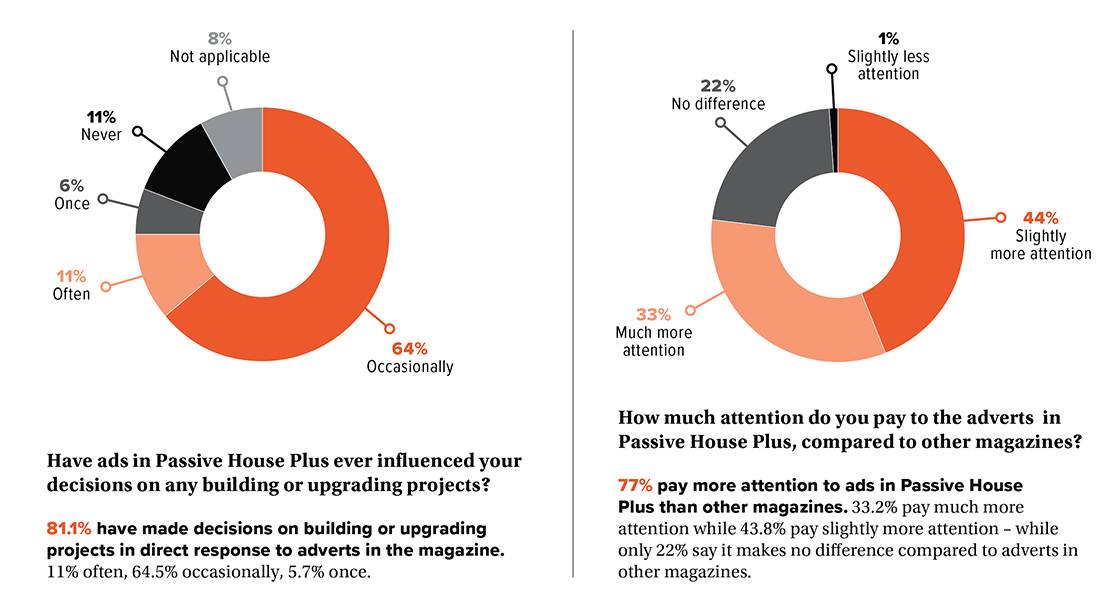
- General
- Posted
Nine out of ten Irish PH+ readers have made decisions based on articles
Nine out of ten readers of Passive House Plus have made decisions on building or upgrading projects in response to articles in the magazine, according to the results of a survey of readers of the magazine’s Irish edition.
Passive House Plus is published to meet a very specific need: to provide detailed technical information on how to build quality, sustainable buildings, at a time when the whole construction industry is required by tightening building standards to do precisely that.
We work hard to help designers and clients to specify the right materials and the right technologies, detailed in the right way, to deliver successful buildings – and to find the right products and service providers to make this happen. Our reader survey shows that our readers – the vast majority of whom are design professionals or self-builders – are responding to adverts and articles in Passive House Plus in exactly the way we would hope. The following survey results relate to our Irish edition.
We work hard to help designers and clients to specify the right materials and the right technologies, detailed in the right way, to deliver successful buildings – and to find the right products and service providers to make this happen. Our reader survey shows that our readers – the vast majority of whom are design professionals or self-builders – are responding to adverts and articles in Passive House Plus in exactly the way we would hope. The following survey results relate to our Irish edition.
Only 3% of surveyed readers bin or recycle the magazine once they’re finished with a given issue – with 76% filed away for reference, 8% shared, and 13% left on display. Seventy-eight per cent of respondents read the magazine from cover-to-cover or read most articles and flick through the rest, while 22% read some articles and flick through the rest. Almost 100% of respondents - 99.6% to be precise – find the magazine’s content relevant in light of tightening building standards – a finding which may indicate a recognition among readers of the magazine’s increasing relevance in light of the nearly zero energy building standard becoming law.
The survey also indicates that the majority of readers are engaging with the magazine’s highly targeted advertisers. Over 94.3% of respondents said the adverts in Passive House Plus are relevant to them, with over 81.1% having made decisions on projects because of adverts in the magazine. Seventy-seven per cent of respondents pay more attention to ads in Passive House Plus than other magazines.
Eighty-two per cent of respondents think a brand looks more credible when it appears in Passive House Plus – while 83% think of the brands that appear regularly in Passive House Plus as some of the main brands involved in sustainable building.
Thirty-four per cent of readers are design professionals, 32% are self-builders, 9% are specialist consultants, 4% are main contractors, 5% subcontractors, and 3% are property developers or corporate/public sector clients. Eighty-five per cent of design professional readers have made decisions on projects in direct response to ads, as have 88% of self-builders.
Fifty-eight per cent of respondents influence projects with a value of €100,000 to €1m, with 9% at €1-5m, 8% are €5-50m, 5% at over €50m – with 19% at under €100,000. Sixty-three per cent are involved in one-off house projects, 27% in multi-unit housing, 23% in commercial, 15% in public buildings, 13% in educational/healthcare buildings, 12% in industrial projects. Given that most respondents are industry professionals, the majority are working on several project types.
Thirty-eight per cent of respondents read the magazine from cover to cover, 40% flick through and read most articles 22% flick through and read some articles, while 1% flick through the magazine but read no articles.
Four-fifths of readers favour case studies as among the most interesting articles in the magazine, while 80% favour our guides to technologies, and 62% favour news on innovative products. The survey indicated there are 2.08 readers per copy of Passive House Plus. Forty-four of copies are read by one person only – but this may be in part because of how closely they guard it – given that 85% of this cohort of respondents file the magazine away for reference after reading.
The online survey was conducted from September to October 2019. The survey was promoted via an email newsletter and a separate email to subscribers. 516 responses have been collected by the time this analysis was completed, including 254 from Irelandbased readers. Note that not all readers answered all questions in the survey – 86.4% completed the entire survey. The survey also included similarly positive results from UK-based respondents – indicating that the UK edition is also making its mark on the construction practices in the UK.
Commenting on the results, editor Jeff Colley said: “Passive House Plus is published to meet a very specific need: to provide detailed technical information on how to build quality, sustainable buildings, at a time when the whole construction industry is required by tightening building standards to do precisely that. “We work hard to help designers and clients to specify the right materials, the right technologies, detailed in the right way, to deliver successful buildings – and to find the right product and service providers to make this happen. Our reader survey shows that our readers – the vast majority of whom are design professionals or self-builders – are responding to adverts and articles in Passive House Plus in exactly the way we would hope.”
To request the full reader survey results, email This email address is being protected from spambots. You need JavaScript enabled to view it..







